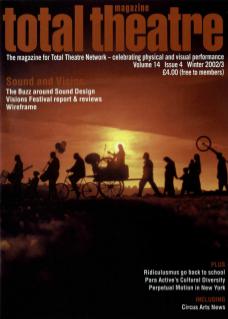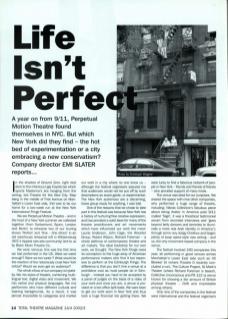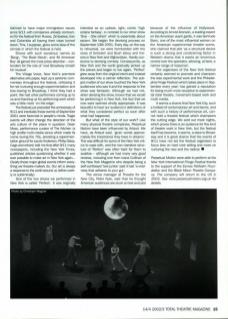In the shadow of Ground Zero, right next door to the infamous Ugly Coyote bar which sports Madonna's bra hanging from the ceiling, lies Theatre for the New City. Slap bang in the middle of First Avenue on Manhattan's Lower East Side, this was to be our home for a two-week run at the New York International Fringe Festival.
We are Perpetual Motion Theatre – and in the heat of a New York summer we collected together (from Switzerland, Spain, London and Berlin) to rehearse two of our touring shows Perfect and One – (the other) in an old warehouse rehearsal loft in Williamsburg (NYC's hippest new arts community) lent to us by Black Moon Theatre Co.
We were nervous; this was the first time we had performed in the US. Were we weird enough? Were we too weird ? What would be the reaction of the notoriously cruel New York critics? Would we even get an audience?
The whole ethos of our company is hybridity. We mix styles of theatre, combining multilingual text, digital video and movement. We mix verbal and physical languages. We mix performers who have different cultural and training backgrounds. As a result, it was almost impossible to categorise and market our work in a city where no one knew us – although the festival organisers assured me that audiences would not be put off by such descriptions as avant garde, or experimental. The New York audiences are a discerning, brave group ready for anything. I was told.
One of the reasons that we chose to take part in this festival was because New York has a history of nurturing free creative expression, and has provided a solid base for many of the theatre practitioners and art movements which have influenced our work the most: Laurie Anderson, John Cage, the Wooster Group, Robert Wilson, Richard Foreman – a whole plethora of contemporary theatre and art makers. The ideal backdrop for our own work, we thought. The New York Fringe owes its conception to the huge array of American performance makers who find it too expensive to perform at the Edinburgh Fringe. The difference is that you don't hire a venue at a prohibitive cost as most people do in Edinburgh – instead you have to be accepted by a panel of judges on the basis of a video of your work and once you are, a venue is provided on a box office split basis. We were keen to get our work seen in New York and thus took a huge financial risk getting there. We were lucky to find a fabulous network of people in New York – friends and friends of friends – who provided support of many kinds.
The venue was ideal for our purposes. We shared the space with nine other companies, who performed a huge range of theatre, including Nibras Collective's fabulous piece about being Arabic in America post 9/11 (called Sajjil, it was a theatrical testimonial woven from recorded interviews and ‘goes beyond belly dancers and terrorists to illuminate a more real Arab identity in America'); through some very dodgy Chekhov and Gogol; plenty of soap opera-style new writing – and us, the only movement-based company in the venue.
The festival involved 190 companies this year, all performing in good venues across Manhattan's Lower East Side such as 45 Bleeker St (where Theatre O recently concluded a run), The Culture Project, St Mark's Theater (where Richard Foreman is based), Collective Unconscious and PS 122 (a venue known for showing a fair amount of British physical theatre – DV8 and Improbable among others).
Only nine of the companies in the festival were international and the festival organisers claimed to have major immigration issues since 9/11 with companies already contracted for the festival from Russia, Zimbabwe, Iran and Colombia all having their visas turned down. This, I suppose, gives some idea of the climate in which the festival is held.
Shows with such wondrous names as Bang, The Boob Movie, and All American Boy all gained the most press attention – contenders for the role of 'next Broadway smash hit musical'.
The Village Voice, New York's premiere alternative arts paper, kept up a sardonic commentary throughout the festival, criticising it for not nurturing enough experimentation and kow-towing to Broadway. I think they had a point. We had other performers coming up to us and thanking us for performing work which was a little more ‘on the edge'.
The festival just preceded the anniversary of 9/11 and inevitably those events of September 2001 were foremost in people's minds. Tragic events will often change the direction of the arts culture of the place in question. Dean Moss, performance curator of The Kitchen (a high profile multi-media venue which made its name during the 70s, providing an experimentation ground for Laurie Anderson, Philip Glass, Cage and others) told me that after 9/11 many newspapers, including the New York Times, published articles questioning whether it was ever possible to make art in New York again... Clearly these major global events inform everything we theatre-makers do. Our art is always a response to the world around us (either overtly or subliminally).
One of the two shows we performed in New York is called Perfect. It was originally intended as an upbeat, light, comic 'high octane fantasy’, in contrast to our other show One – (the other), which is essentially about racism. We began the devising process on September 13th 2001. Every day, on the way to rehearsal, we were bombarded with the news of terrorism and Bush idiocy and horrors in New York and Afghanistan. Hardly conducive to devising comedy. Consequently, as New York and the world gradually picked up the pieces and began to live again, Perfect grew away from the original intent and instead developed into a calmer reflection. The subject matter of our show touched the New York audiences who saw it and the response to the show was fantastic. Although we had not, when devising the show, known that we would be performing it in New York, the fact that we now were seemed wholly appropriate. It was beautiful to hear our audience's definitions of what they considered perfect so soon after what had happened.
But what of the style of our work? Like many physical theatre companies, Perpetual Motion have been influenced by Artaud. We have, as Artaud said, 'given words approximately the importance they have in dreams'. This was difficult for some of the New York critics to cope with, and the non-narrative structure of Perfect was often hard for them to swallow – although we had many very good reviews, including one from Ivana Cullinan of the New York Magazine who, despite being a self-confessed 'text junkie', said it had 'a vividness that adheres to your gut'.
The venue manager at Theatre for the New City, Peter Kyte, said that he thought American audiences are stuck on text and plot because of the influence of Hollywood. According to Arnold Aronson, a leading expect on the American avant garde, it was Gertrude Stein, one of the most influential women on the American experimental theatre scene, who claimed that plot 'as a structural device is such a strong and constraining factor in Western drama that it exerts an enormous control over the spectator, allowing, at best, a narrow range of response’.
The organisers of the New York festival certainly seemed to promote and champion the less experimental work and the Philadelphia Fringe Festival (which takes place in September every year) has gained a reputation for being much more receptive to experimental total theatre, movement-based work and multimedia.
It seems a shame that New York City, such a hotbed of contemporary art and dance, and with such a history of performance art, cannot hold a theatre festival which champions the cutting edge. We sold out most nights, which proves there is an audience for this kind of theatre work in New York, but the festival itself has become, it seems, a slave to Broadway and it is great shame that the events of 9/11 have not led the festival organisers to focus less on hardcore selling and more on nurturing the new and the radical.
Perpetual Motion were able to perform at the New York International Fringe Festival thanks to the support of the Esmee Fairbairn Foundation and the Black Moon Theatre Company. The company will return to the US in 2003. See www.perpetualmotion.org.uk for details.


